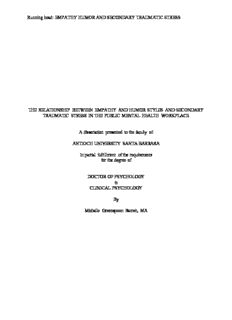
The Relationship Between Empathy and Humor Styles and Secondary Traumatic Stress in the ... PDF
Preview The Relationship Between Empathy and Humor Styles and Secondary Traumatic Stress in the ...
Running head: EMPATHY HUMOR AND SECONDARY TRAUMATIC STRESS THE RELATIONSHIP BETWEEN EMPATHY AND HUMOR STYLES AND SECONDARY TRAUMATIC STRESS IN THE PUBLIC MENTAL HEALTH WORKPLACE A dissertation presented to the faculty of ANTIOCH UNIVERSITY SANTA BARBARA In partial fulfillment of the requirements for the degree of DOCTOR OF PSYCHOLOGY in CLINICAL PSYCHOLOGY By Michelle Greenspoon Barrett, MA EMPATHY HUMOR AND SECONDARY TRAUMATIC STRESS Copyright 2015 Michelle Greenspoon Barrett All rights reserved ii EMPATHY HUMOR AND SECONDARY TRAUMATIC STRESS THE RELATIONSHIP BETWEEN EMPATHY AND HUMOR STYLES AND SECONDARY TRAUMATIC STRESS IN THE PUBLIC MENTAL HEALTH WORKPLACE This dissertation, by Michelle Greenspoon Barrett, MA, has been approved by the committee members signed below who recommend that it be accepted by the faculty of Antioch University Santa Barbara in partial fulfillment of requirements for the degree of DOCTOR OF PSYCHOLOGY Dissertation Committee: ______________________________ Sharleen O’Brien, PsyD Chairperson ______________________________ Brett Kia-Keating, EdD Second Faculty ______________________________ Thomas E. Eby, PhD External Professional iii EMPATHY HUMOR AND SECONDARY TRAUMATIC STRESS ABSTRACT The purpose of this study was to determine if there is a relationship between both empathy type and humor type to secondary traumatic stress in individuals who work in a public mental healthcare setting. Empathy type was divided into four subcategories: Perspective Taking, Fantasy-type, Empathic Concern, and Personal Distress. Similarly, humor type was divided into four subcategories: Affiliative, Self-Enhancing, Aggressive, and Self-Defeating. Clinical and non-clinical staff at the Alcohol, Drug, and Mental Health Services department of Santa Barbara County, California participated in an online survey. The survey consisted of a sociodemographic questionnaire, as well as questionnaires related to humor, empathy, and secondary traumatic stress. Non- clinical staff was more likely to endorse STS and to report significantly higher scores Personal Distress Empathy scale, in comparison to clinical staff. Further, a significant relationship was found in both clinical and non-clinical workers to Perspective Taking and Fantasy-type Empathy. Finally, both clinical and non-clinical staff who endorsed significantly higher STS were also more likely endorse higher scores on Self-Defeating and Self-Enhancing Humor scales. Results showed that non-clinicians were more likely to report psychological distress than their clinical counterparts. Further, humor related to oneself was likely to be indicative of STS, as were the cognitive empathy types. The electronic version of this dissertation is available free at Ohiolink ETD Center, www.ohiolink.edu/etd. iv EMPATHY HUMOR AND SECONDARY TRAUMATIC STRESS ACKNOWLEDGMENTS I am extremely grateful for the support of my family, friends, and dissertation committee members. I would like to thank my husband, Scott Barrett, for his love, kindness, and patience as I completed this dissertation manuscript. My parents and friends also provided me with tremendous support throughout this process. Thank you for being my cheerleaders. Finally, I would like to thank each of my committee members: Dr. Sharleen O’Brien, Dr. Brett Kia- Keating, and Dr. Thomas Eby, who committed tremendous time and energy to guiding me throughout this project. Thank you all, I could not have completed this manuscript without you. v EMPATHY HUMOR AND SECONDARY TRAUMATIC STRESS TABLE OF CONTENTS List of Tables……………………………………………………………………………………viii List of Figures…………………………………………………………………………………….ix CHAPTER I: Background and rationale for the study Introduction and background………………………………………………...…………... 1 Scope of the study………………………………………………………………………....7 CHAPER II: Review of the literature Literature review…………………………………………………………………………..9 Coping strategies………………………………………………………………..…………9 Humor………………...………………………………………………………………….13 Empathy………………………………………………………………………………….22 Secondary traumatic stress…………………………………………………………….....25 Research questions…………………………………………………………….................30 Research hypothesis……………………………………………………………………...31 CHAPTER III: Research design and methodology Research design……………………………………………………………………..…...33 Participants………………………………………………………………………..……...34 Measurements………………………………………………………………….………...35 Empathy………………………..…………………………………….…….….....35 Humor…………………………………………………….……….......................35 Secondary traumatic stress………………………………………...…………......36 Sociodemographic questionnaire…………………………………………..…….36 Data collection……………………………………………………..…………………….36 Data analysis procedures…………………………………………………………………36 Research question one………………………………………………………...……….....37 Research question two……………………………………………………………...…....37 Research question three……………………………………………………………….....38 Research question four………………………………………………………………...…38 CHAPTER IV: Results Sample selection and characteristics……………………………………………………..40 Data analysis……………………….…………………………………………….............40 Answering the research questions………………………………………………………..43 CHAPTER V: Discussion and conclusions Summary of findings…………………………………………………………………….45 Implications and consistency of findings………………………………………………..45 Limitations and future research……………………………………………….................46 Conclusions…………………………………………..……………………………..........47 REFERENCES…………………………………………………………………………………..50 vi EMPATHY HUMOR AND SECONDARY TRAUMATIC STRESS APPENDICES Appendix A: Approval from ADMHS…………………….…………………………...66 Appendix B: Informed consent form……….…………….…………….……................67 Appendix C: Correlations Matrix……………………………………………………....70 vii EMPATHY HUMOR AND SECONDARY TRAUMATIC STRESS LIST OF TABLES Table 1. Comparative Definitions of Trauma Concepts…………………………………………28 Table 2. Correlation Matrix…………………………………………………………...Appendix C Table 3. Full Multiple Regression Model………………………………………………………..41 viii EMPATHY HUMOR AND SECONDARY TRAUMATIC STRESS LIST OF FIGURES Figure 1. The two-dimensional model of humor styles assessed by the Humor Styles Questionnaire……………………………………………………………………………………… ……...16 ix EMPATHY HUMOR AND SECONDARY TRAUMATIC STRESS 1 CHAPTER I: BACKGROUND AND RATIONALE FOR THE STUDY Introduction and Background “If I couldn’t make jokes, I swear I would eat my gun one day.” Anonymous Santa Barbara County Law Enforcement Agent (personal correspondence, 2013) Emergency services professionals have jobs that are characterized by consistently high levels of stress (Rowe & Regehr, 2010). Physicians, nurses, and other health care professionals in the emergency services community and in hospital-based emergency settings are faced, on a daily basis, with exposure to a multitude of death, injury, and danger. In addition to the training that emergency professionals receive on the job, often individuals who choose these jobs inherently share personality traits that protect against stress and distress (Regehr, Hill, & Glancy, 2000; Shakespeare-Finch, Gow, & Smith, 2005;Waysman, Schwarzwald, & Solomon, 2001). In spite of these inherent traits, emergency service professionals can suffer the toll of exposure to stress, specifically trauma responses. Events that involve any threat of actual death or injury to oneself or others, and produce profound changes to human arousal, emotion, cognition and memory are considered traumatic (Herman, 1992). Individuals exposed to traumatic stressors have reported adverse physical health outcomes as well as alterations of psychological, biological, and social equilibrium (van der Kolk & Fisler, 1995). Previous research reveals that exposure to trauma can have a significantly negative impact on an individual’s well being (Grevin, 1996). In 2005, Johnson and colleagues compared 26 high- demand occupations from a database of 25,000 individuals. Paramedics ranked first of all occupations studied in terms of negative impacts on physical health, fourth in negative impacts on psychological well-being, and second in low job satisfaction. Nursing staff (seventh),medical
Description: